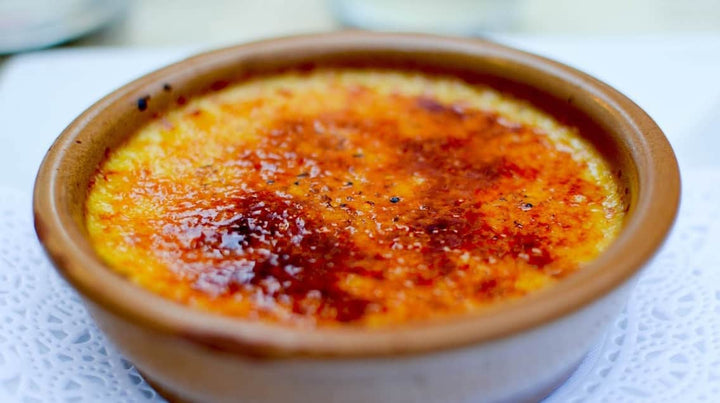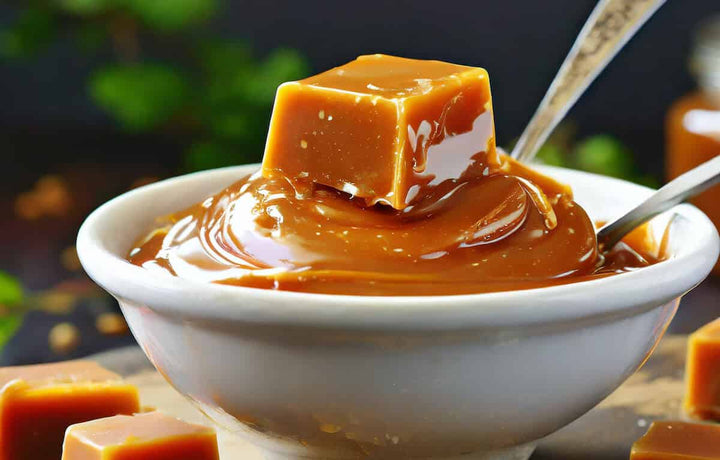Crème Caramel, a classic dessert that has charmed its way into the hearts of food enthusiasts globally, is a study of elegant simplicity and delicate flavours.
In this post, we will immerse ourselves in the delightful world of this beloved dessert, exploring its origins, lusciously smooth texture, and the perfect balance of flavours it offers.
This dish, also known as 'flan' in some cultures, is a testament to culinary finesse and a celebration of how a few basic ingredients - milk, eggs, sugar, and vanilla - can be transformed into an exquisite and sophisticated dessert.
What is Creme Caramel?
Crème Caramel, also known as caramel custard or flan in various parts of the world, is a sumptuous dessert consisting of two layers: a rich, smooth custard base and a layer of soft caramel.
It is a popular dessert in many cuisines due to its delightful texture and exquisite balance of flavours.
The base of Crème Caramel is a simple custard made from eggs, sugar, and milk or cream, often flavoured with vanilla.
This mixture is gently cooked in a bain-marie (water bath) in the oven or stove until it achieves a silky, pudding-like consistency.
The custard is known for its delicate, creamy texture, which forms the perfect backdrop for the caramel.
The caramel, made by melting sugar until it reaches a golden-brown colour, is poured into the bottom of the mould before the custard mixture is added.
When the dessert is served, it is inverted onto a plate, allowing the caramel to flow over and around the custard, creating a glistening topping that is both sweet and slightly bitter.
This caramel layer adds a luscious flavour and a lovely texture contrast to the smooth custard.
Crème Caramel is typically chilled before serving, making it a refreshing and elegant end to a meal.

What Does Creme Caramel Taste Like?
The taste experience of Crème Caramel is characterised by the harmonious blend of the creamy, gentle custard with the rich, sweet, and slightly bitter caramel topping.
Traditionally flavoured with vanilla, the custard base has a mild, sweet, and subtly fragrant taste.
Made from a mixture of eggs, sugar, and milk or cream, it is cooked to a smooth, silky consistency.
This creamy custard is not overly sweet, which balances perfectly with the caramel.
The caramel layer, on the other hand, provides a contrasting taste to the custard.
Together, the soft, velvety custard and the rich, flowing caramel combine to create an indulgent dessert that is not overpowering.
How Do You Make Creme Caramel at Home?
Making Crème Caramel at home is a delightful way to bring a touch of elegance to your dessert table.
It requires patience and precision, but the result is a lusciously smooth custard with a rich caramel topping. Here's a basic recipe to create this classic dessert:
Ingredients:
- For the Caramel:
- 150g granulated sugar
- 3 tablespoons water
- For the Custard:
- 500ml milk (whole milk works best)
- 4 large eggs
- 1 teaspoon vanilla extract
- 100g granulated sugar
Method:
-
Preheat the Oven: Preheat your oven to 150°C (300°F).
-
Prepare the Caramel: In a saucepan, gently heat 150g sugar and the water over medium heat. Swirl the pan occasionally (do not stir) until the sugar dissolves and turns golden brown. Quickly pour the caramel into ramekins or a baking dish, tilting them to coat the base evenly. Set aside to cool and harden.
-
Warm the Milk: In another saucepan, gently warm the milk over low heat until it’s hot but not boiling.
-
Whisk the Eggs and Sugar: In a mixing bowl, whisk together the eggs, vanilla extract, and 100g sugar until well combined but not frothy.
-
Combine with Milk: Add warm milk to the egg mixture, whisking continuously.
-
Strain the Mixture: Strain the mixture through a fine sieve into a jug or bowl to ensure a smooth custard.
-
Pour into Ramekins: Pour the custard mixture over the hardened caramel in the ramekins.
-
Bake in a Bain-Marie: Place the ramekins in a deep baking tray. Fill the tray with boiling water until halfway up the sides of the ramekins. This water bath (bain-marie) ensures gentle cooking.
-
Bake: Bake for 30-40 minutes, or until the custard is set but still slightly wobbly in the centre.
-
Cool and Chill: Remove the ramekins from the oven and water bath, let them cool to room temperature, then refrigerate for at least 2 hours.
-
Serve: To serve, run a knife around the edge of each ramekin and invert onto a serving plate. The caramel sauce will flow over the custard.
Remember, patience is key when making Crème Caramel.
The caramel requires close attention as it can quickly go from perfect golden brown to burnt.

What is the History of Creme Caramel?
The history of Crème Caramel, also known as caramel custard, flan, or caramel pudding, is a fascinating blend of global culinary influences.
This beloved dessert has roots spanning several countries and centuries, reflecting the evolution of cooking techniques and ingredients.
-
Early Beginnings in Europe: The concept of cooked cream or custard is ancient, with early versions appearing in mediaeval European cuisine. These custards were typically baked in pastry or in dishes lined with caramelised sugar, forming the basis of what would evolve into Crème Caramel.
-
Spanish and French Influence: The modern version of Crème Caramel is thought to have developed in Spain and France. A dessert similar to 'flan' has been a traditional sweet for centuries in Spain. The French version, called 'Crème Caramel', became popular in the 19th century. Both versions involve a custard base made with eggs and milk and a layer of clear caramel.
-
Global Spread: From Europe, the dessert spread to various parts of the world, taking on local flavours and nuances. In Latin America, particularly in Mexico and the Caribbean, flan became a staple dessert, often infused with local ingredients like coconut, coffee, or citrus.
-
Popularity in Asia: In Asia, particularly in the Philippines and Japan, versions of Crème Caramel (leche flan in the Philippines and purin in Japan) have become beloved treats, reflecting a fusion of local tastes with the traditional recipe.
-
Contemporary Variations: Today, Crème Caramel is a staple dessert in many countries, appreciated for its simplicity and elegance. Modern interpretations might include the addition of flavours like vanilla, citrus zest, or liqueurs to the custard.
The history of Crème Caramel is a testament to the dessert's versatility and enduring appeal.
It's a simple yet sophisticated dish that has stood the test of time, adaptable to different tastes and cultures.
It remains a favourite in home kitchens and fine dining restaurants worldwide.
How to Pronounce Creme Caramel
In UK English, 'Crème Caramel' is typically pronounced as 'krem ka-ra-mel'.
This pronunciation is broken down into three syllables:
- 'krem': Pronounced like the English word 'cream', but with a shorter 'e' sound.
- 'ka': Pronounced like the 'ca' in 'cat'.
- 'ra-mel': The 'ra' is pronounced like the 'ra' in 'rapid', and 'mel' like the word 'mell' in 'mellow'.
It's important to note that the 'r' in 'crème' and 'caramel' is softly pronounced, reflecting the French origin of the term.
The emphasis is usually on the second syllable, 'ra', giving it a distinctly elegant and French-inflected sound.
However, regional accents and variations might lead to slightly different pronunciations, but the above is the most commonly accepted way to pronounce 'Crème Caramel' in the UK.
What’s the Difference Between Creme Caramel and Creme Brulee?
Crème Caramel and Crème Brûlée are both classic French desserts, beloved for their creamy textures and rich flavours.
Despite some similarities, they are distinct in preparation, texture, and presentation.
Texture and Composition:
Crème Caramel: This dessert consists of a smooth, silky custard base, typically flavoured with vanilla, topped with a soft layer of dark caramel sauce.
The caramel is created by cooking sugar until it liquefies and becomes golden, and it's poured into the mould before adding the custard mixture.
After baking and chilling, the dessert is inverted onto a plate, allowing the caramel sauce to flow over and around the custard.
Crème Brûlée: Crème Brûlée also features a rich, creamy custard base, but the key difference lies in its iconic top layer – a hard, caramelised sugar crust.
This crust is formed by sprinkling the baked custard with a thin layer of sugar and then using a kitchen torch (or a broiler) to caramelise the sugar, creating a crisp, brittle topping.
Method of Serving:
Crème Caramel: It is usually served inverted, with the caramel sauce at the bottom of the mould now elegantly coating the custard.
Crème Brûlée: Served in its ramekin, the custard is not inverted.
The pleasure of Crème Brûlée lies in cracking the hard caramel top with a spoon to reach the soft custard beneath.
Flavour Profile:
Crème Caramel: The caramel sauce in Crème Caramel imparts a sweet and slightly bitter flavour, complementing the mild custard.
Crème Brûlée: The burnt sugar topping of Crème Brûlée offers a toasty, slightly bitter contrast to the sweet, vanilla-infused custard.
So, while both desserts share a custard base, Crème Caramel is characterised by its soft caramel topping and inverted serving style, whereas Crème Brûlée is distinguished by its crisp, caramelised sugar crust.
Where Can You Buy Tasty Chocolate?
Whitakers Chocolates, renowned for our long history in crafting delicious and affordable chocolates, offers a range of options suitable for everyone, including vegetarian, vegan, and gluten-free choices.
Our top-selling products, such as indulgent Coffee Creams, Neapolitans, Chocolate Wafer Thins, Stem Ginger and Luxury Chocolate Truffles, are perfect for enhancing your mocha coffee experience.
Click here to see our full range of delicious chocolates…
Final Notes On Creme Caramel
Crème Caramel stands as a timeless dessert, a testament to the elegance and simplicity of classic culinary techniques.
Its allure lies in the harmonious balance of textures and flavours – the smooth, velvety custard gracefully complemented by the rich, flowing caramel.
This dessert delights the palate and offers an aesthetic appeal, with its golden caramel elegantly cascading over the creamy custard when served.
The enduring popularity of Crème Caramel can be attributed to its versatility and the ease with which it can be adapted to incorporate various flavours, making it a favourite across different cultures and cuisines.











